ScholarOne Manuscripts Q4.2022
iThenticate V2 in Client Configuration Center
Updated Client Configuration Center to include Plagiarism Checking page which will allow users with client configuration center access to adjust iThenticate V2 settings. Previously, admins could only make configuration adjustments from the admin dashboard if the integration was initially set up with admin access. Moving this into the Client Configuration Center will allow more flexibility for power users to update report generation settings without contacting Support.
Users:
|
|
| Action required.
iThenticate V2 integration must first be enabled and credentials provided; reach out to ScholarOne support to assist with upgrading from V1 to V2, or enabling V2 on a new site. |
Details & Configuration
- Navigate to the Client Configuration Center
- Go to Configure This Site and click on Step 16 Plagiarism Checking
- Make the selections to define how Similarity Reports should be generated for the site
NOTE: Do not make changes to the Turnitin URL or API key fields; this will disconnect your site’s integration and Similarity Reports will no longer be generated.
Auto-save changes to iThenticate V2 Similarity Check reports
Added a configuration option to auto-save changes in the Similarity Report pop-up window. If this option is checked, all changes made to a given report will save when the window is closed and restore when/if the report is re-opened. All user changes will be saved; the last set of changes made to a report will be the ones to restore when the report is re-opened by any user. Changes to a given report may include adjustments to exclusion filters or search repositories.
Users:
|
|
|
| Action required.
Configuration will be ON by default for sites with an active iThenticate V2 integration during the release. Configuration will be OFF by default for sites enabling V2 in the future. |
Details & Configuration
- Navigate to the Client Configuration Center
- Go to Configure This Site and click on Step 16 Plagiarism Checking
- Update the selection for Save changes in the Similarity Report popup
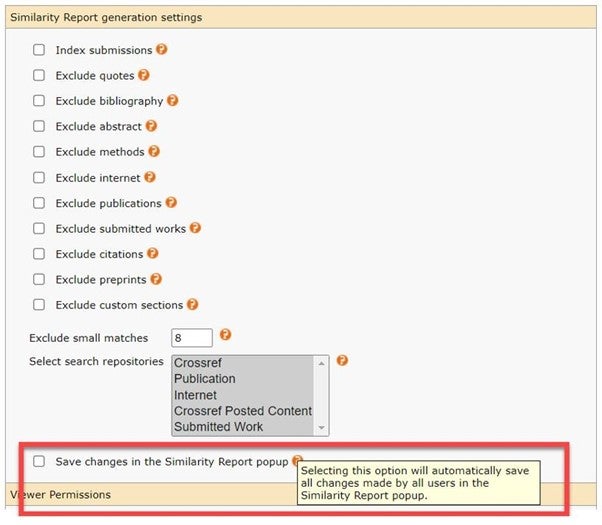
“Search” technology upgrade
Upgraded the search engine technology that ScholarOne Manuscripts uses (called “Elasticsearch”) to a new version. Elasticsearch powers several different searches in S1M, including Research Interest, Keywords, and Duplicate Submission Checker.
Benefits of this upgrade:
- Improved search client: S1M will have more control over fine-tuning searches with the outcome of higher-quality results for the end-user.
- Support: S1M will receive support from central Clarivate teams dedicated to providing technical support and resolution for Elasticsearch.
- Maintenance: The upgrade will include several internal maintenance tools developed to monitor and quickly identify search issues as they arise.
- Security: The upgrade provides additional system security, strengthening areas of vulnerability against potential threats.
- Future improvements: S1M will be able to develop and/or improve other search functions in the future using the new version.
Users:
|
|
|
|
|
| Action required.
Available by default following a transition plan. No configuration required. |
Details & Configuration
Areas that will be improved by the upgrade:
- Keyword and Research Interests: The data is based on the user-selected keywords and user-entered Research Interest:
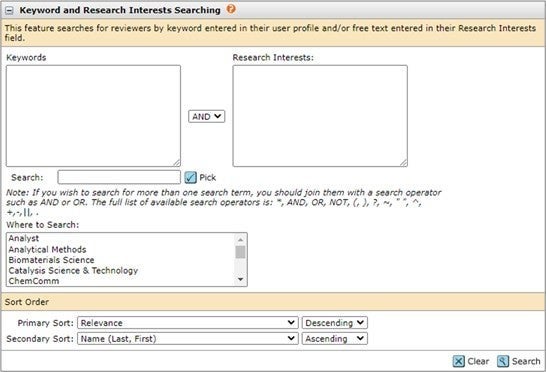
- Duplicate Submission Check: The data for the Document (Dup Doc) search is based on the fields available in the document advanced search

Pagination on Reviewer List
Added pagination to the reviewer list to only display 10 records at a time.
Previously, if a manuscript had large numbers of reviewers, it would be susceptible to repeated gateway timeout errors, preventing editors/admins from accessing the manuscript. Adding this pagination will eliminate the gateway timeout error for this issue and make large lists more manageable.
Users:
|
|
|
| Action required.
Available by default. No configuration required |
Details & Configuration
If a reviewer list has more than 10 reviewers selected/invited/responded to a manuscript, Editors/Admins will now page through the list instead of seeing all records on one page:
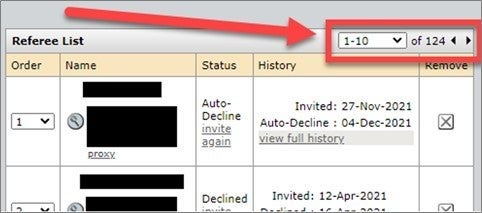
Auto-refresh page with custom question dependencies
Added auto-refresh functionality for custom questions that are configured with dependencies attached to their responses.
Users:
|
|
|
|
|
|
|
| Action required.
Available by default. No configuration required. |
Details & Configuration
Custom questions can be configured with dependencies; i.e. if a user selects a certain response to a custom question, the system can then display another question specific to that response (based on the configuration).
Previously, this dependent question would only be displayed after a manual page refresh or on a new page. With the new auto-refresh functionality, upon selection of the response associated with a dependency, the page will refresh immediately and display the dependent question for the user to answer.
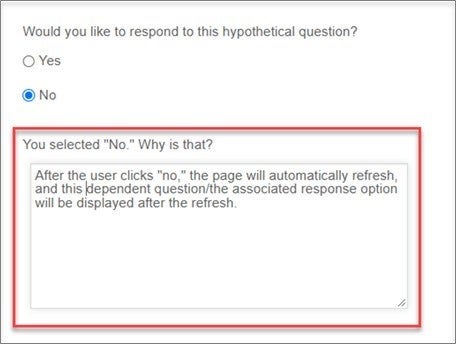
Decision/recommendation custom question “req” display updates
Updated “req” display for decision custom questions so that “req” symbol appears next to the question only (no longer appears alongside all response options).
Users:
|
|
|
| Action required.
Available by default. No configuration required. |
Details & Configuration
If there is more than one answer configured for a checkbox question at the decision task, the “req” symbol or red asterisk will only display next to the question, and not after all answer options.
API Services: Custom Questions on Tasks
Added data for task-based custom questions to the getSubmissionFull V6 API.
Users:
|
| Action required.
To leverage use of this API, you must be a ScholarOne Web Services client and will need to upgrade to V6. If you want to learn more about using this API, reach out to your Account Director. |
Details & Configuration
- Custom questions will be output with their relevant task (e.g. checklist, scoresheet, recommendation), as a sub-object of ‘task’
- All tasks will be included, even completed tasks, regardless of task status
- Data in the XML will output in DocumentTaskId order
Sample output:
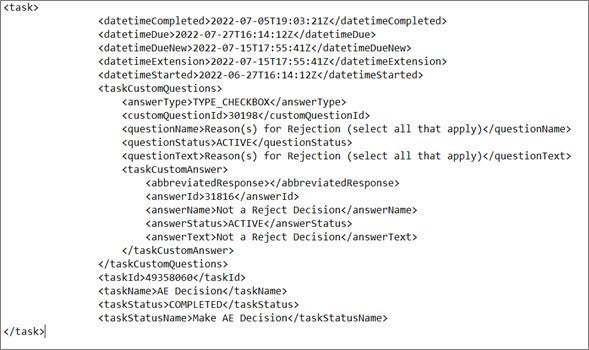
Notification Services: Rescind Notification
Added a new System Event notification when a task on a manuscript has been rescinded (only valid for Reviewer Score, Recommendation, and Decision tasks).
Users:
|
|
|
| Action required.
Visible to all existing Web Service Clients. If you are not a Web Service Client and want to learn more, please contact your Account Director. |
Details & Configuration
From the Integration Dashboard, navigate to Notification Services Subscriptions. Example configuration below:
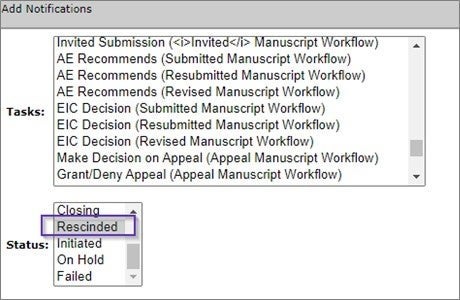
Notification Services: Invited Author Response
Added a new System Event notification when an author responds to an invitation to submit
Users:
|
|
|
| Action required.
Visible to all existing Web Service Clients. If you are not a Web Service Client and want to learn more, please contact your Account Director. |
Details & Configuration
From the Integration Dashboard, navigate to Notification Services Subscriptions. Example configuration below:
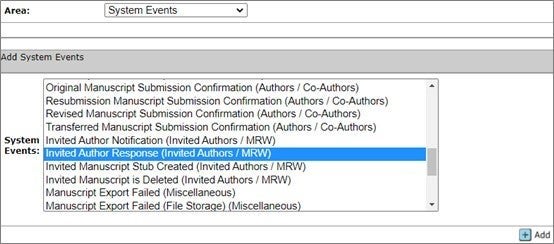
Submission Integration*: Adding Emails to Audit Trail
For sites with a Submission Integration setup: added the ability to provide external email correspondences to the audit trail in S1M via the external integrated platform.
Users:
|
| Action required.
Available by default to all customers utilizing Submission Integration. |
Details & Configuration
- Certain fields can be passed in the JATS XML as part of the submission package that will add email correspondence to the audit trail.
Example format for XML:
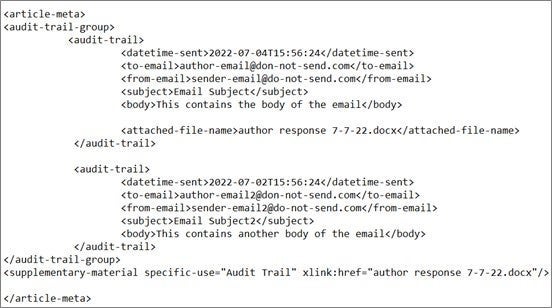
* Submission Integration is a set of features in ScholarOne allowing external systems such as publisher portals and preprint servers to push manuscripts into journal sites.
Submission Integration*: Lock Icon for Manuscripts
For sites with a Submission Integration setup: added a padlock symbol that will display next to the manuscript ID when the paper is in a locked state. This will indicate whether the manuscript is locked for changes or is open for editing by the author.
Users:
|
|
|
| Action required.
Available by default to all customers utilizing Submission Integration. |
Details & Configuration
The padlock symbol will appear next to the manuscript ID on the following pages:
- View Manuscript
- Search result list
- Manuscript Details header
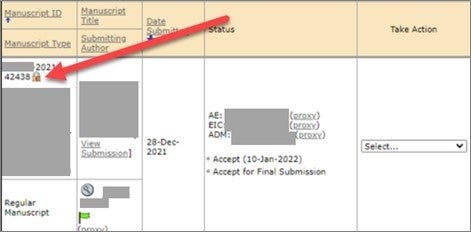
* Submission Integration is a set of features in ScholarOne allowing external systems such as publisher portals and preprint servers to push manuscripts into journal sites.
Notable Defect Fixes & Functionality Optimizations
- Email tags associated with custom questions at decision task not working
Resolved an issue in which email tags for decision custom questions were not rendering in sent emails. - System timeout when trying to access Configuration Audit Trail
Resolved an issue in which system was returning a gateway timeout error when attempting to download Configuration Audit Trail file. - Plagiarism checking error when trying to delete manuscript files from a rescinded submission
Resolved an issue in which authors were unable to delete files from unsubmitted manuscripts if the submission had been sent to iThenticate for processing. - iThenticate Configuration Tools not appearing for sites newly integrated with iThenticate
Resolved an issue in which “iThenticate Configuration Tools” and the subsequent plagiarism checking “History” link was not appearing for sites being configured with iThenticate for the first time - Audit Trail is not updated when Admin/Editor updates custom question response for scoresheet, recommendation, or decision
Resolved an issue in which Audit Trail was not recording when an Admin/Editor changed a custom question response.
Note: ScholarOne deploys a number of patches and hotfixes between releases, ensuring that our users experience constant improvements to the platform. Many of these are driven by internal teams to optimize processes and therefore do not affect workflows. If you have questions about any of these changes, however, please reach out to Support.